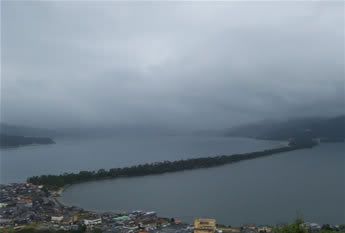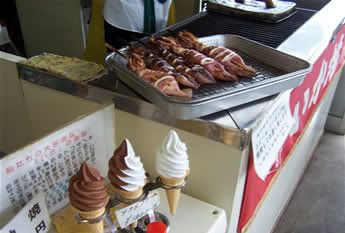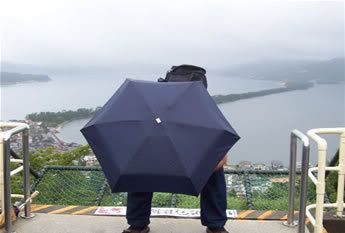Amanohashidate - the bridge to heaven
The Japanese are fond of compiling lists of their most highly-prized national assets. Helpfully written as a series of top-threes, there are the three greatest castles, gardens, moon-viewing locations, Hello Kitty theme parks, etc - and sights. Being fond of the odd sight I managed to fit two of the three 'Great Sights of Japan' into the trip, and the first of those we visited today. The town of Amanohashidate is a two-hour train ride north of Kyoto. This was good in itself, as it allowed us to see rural and coastal areas of Japan we would normally blast through on the Shinkansen. The actual town of Amanohashidate (which I discovered has the same telephone dialling code as my hometown in the UK) is divided into two parts, almost 4km away, on opposing sides of a coastal bay. What splits the halves is what people come to look at - and in an unusual way (but more of that later).
The town`s name means 'The Bridge to Heaven', and the connection between the halves is the bridge - a long, narrow sand spit covered with almost 10,000 pine trees. Unfortunately we arrived in the rain, and walked through the soggy streets to the start of the sand spit. Looking at the shops on either side of the road, the main industry appeared to be drying seafood - every one had a rack of flattened, crispy squid and fish. One had a large, translucent, octopus dangling from a coathanger, swinging around in the breeze looking more like an octopus-shaped kite than the real thing.
Ice-cream or squid on a stick? Tough choice...
It took about 45mins to cross the sand spit, walking along a gravel path that ran up the centre. The rain eased the further along we got - but the people didn`t. There was some kind of sponsored walk going on, so we walked against a continual flood of people all the way. Either side of the bridge boats cruised up and down, ferrying people around who wanted a more direct route. They docked at the far end of the spit, in front of the Kono Shrine. It seemed to be a shrine that worshipped turtles, as several of them were sitting in a watery pit at the main entrance. At the other end of the shrine enclosure were more dried squid shops and a funicular railway to a viewing platform at Kasamatsu Park. We rode to the top - sadly the individual seat chairlift was out of action. The view at the top was well worth the effort - and by this time the rain had stopped.
Dad looking at the Bridge in the proper way
The sand spit cuts across the bay on a diagonal, and although the surrounding hills were obscured by cloud, we could see the whole thing. The correct way to view the Bridge to Heaven is 'Mata-nozoki' - by turning around, bending over, and looking at it between your legs. If you do this the spit is supposed to resemble a bridge climbing the sky to heaven. Well, to me it looked just the same, only upside-down. The blood rushing to your head might be a clue as to why some people think that it looks like a bridge to heaven, but I really couldn`t see it. It was great fun though, and good to see everyone having a go, young and old. After descending the funicular we got a boat across the water and caught a train back to Kyoto.